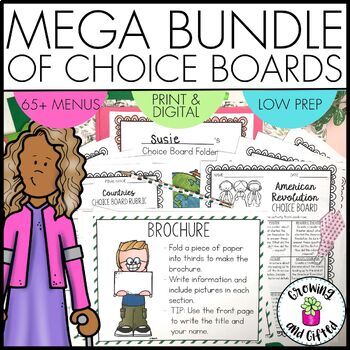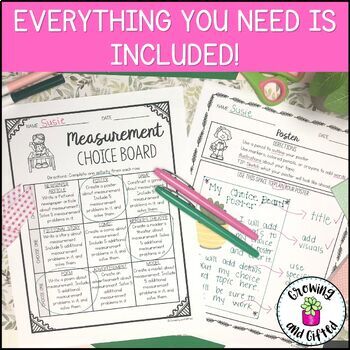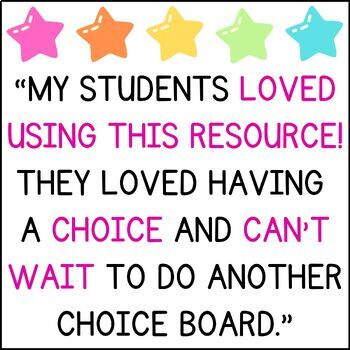Choice Boards for Enrichment & Early Finishers - Includes 65+ Menus and Growing!
- Various file types
- Google Apps™
- Easel Activity

Products in this Bundle (48)
showing 1-5 of 48 products
Bonus
Description
Searching for no-prep and differentiated choice boards in math, science, and social studies for enrichment and early finishers? Choice boards are excellent for ALL students, including gifted and intervention students! These 65+ choice board menus are perfect for reviewing and extending what you've taught in class.
Printable and digital versions are both included, plus I'm continuing to add additional choice boards!
What Is Included in This Resource?
- Months/Holidays Choice Boards
- Back to School
- End of Year
- Halloween
- Thanksgiving
- Christmas
- New Year's
- Valentine's Day
- Black History Month (12 Choice Boards)
- Booker T. Washington
- Dr. Martin Luther King, Jr.
- Frederick Douglass
- George Washington Carver
- Harriet Tubman
- Mary McLeod Bethune
- President Barack Obama
- Rosa Parks
- Ruby Bridges
- Sarah E. Goode
- Sojourner Truth
- Thurgood Marshall
- Women's History Month (15 Choice Boards)
- Anne Frank
- Dr. Elizabeth Blackwell
- Florence Nightingale
- Georgia O'Keeffe
- Helen Keller
- Julia Child
- Louisa May Alcott
- Dr. Mae Jemison
- Malala Yousafzai
- Dr. Marie M. Daly
- Mary Anning
- Maya Angelou
- Sacagawea
- Susan B. Anthony
- Queen Elizabeth II
- Women's History Month (15 Choice Boards)
- Presidents' Day / Washington's Birthday
- MORE coming soon!
- Math Choice Boards
- 2-D Figures
- Addition
- Area
- Decimals
- Division
- Fractions
- Lines of Symmetry
- Measurement
- Multiplication
- Place Value
- Subtraction
- Science Choice Boards
- Animal Research
- Astronomy
- Dinosaurs
- Earth's Movement
- Energy
- Food Sources
- Heat
- Heredity, Instincts, & Learned Behaviors
- Human Body
- Mass & Volume
- Matter
- Moon Phases
- Motion & Speed
- Plant Reproduction & Life Cycles
- Recycling
- Rocks & Minerals
- Studying Science
- Weathering, Erosion, & Deposition
- Social Studies Choice Boards
- American Revolution
- Biography
- Branches of Government
- Countries
- Maps
- Native Americans
- States
- U.S. Regions
- You Will Also Receive
- Editable Student Pages for Each Choice Board Activity
- The Teacher's Guide to Using Choice Boards in Elementary Classrooms
- Printable and Digital Choice Board Posters
- Detailed Teaching Tips
- Choice Board Folder Covers
- Rubrics
- Editable & Non-Editable Digital Versions on Google Slides™ and TpT Easel
On each choice board, students choose one activity from each row. They can work independently or collaboratively on the activities. These are differentiated for multiple learning styles, including auditory, visual, and kinesthetic.
___________________________________________________________________
What Teachers Have Said:
"Due to distance learning, I was looking for activities for my younger Enrichment students. This is a great resource--exactly what I was looking for! Thank you so much!"
"Great resource for students to have choice. Great for the distant learning that we are currently under until the end of the school year."
"My students loved using this resource! They loved having a choice and can't wait to do another choice board."
"Great resource! Thanks for the time you put into it!"
___________________________________________________________________
How Can You Use Choice Boards?
- Assessment (a rubric is provided)
- Centers / Rotations / Stations
- Distance Learning / Digital Learning
- Early Finisher Work
- Enrichment for Gifted & High-Achieving Students
- Extension
- Homework
- Morning Work / Seat Work / Bell Work
- Substitute Teacher Days
- Whole Class
Why Should You Use Choice Boards?
- Students love choice boards because they can choose which activities they’d like to complete.
- If you have gifted or high-level students, choice boards are excellent to use for extension and enrichment.
- I recommend having students choose one activity from the first row, one from the second row, and one from the third row to be sure a variety of topics are covered.
- My choice boards include activities for a variety of learning styles.
- Typically, the first column is for auditory learners, the second column is for visual learners, and the third column is for kinesthetic learners.
- It’s fun to see what types of activities your students choose because it will help you understand what their preferred learning styles are!
Where Can You Find More Information about Using Choice Boards?
- Click here for a free teacher's guide about using choice boards in your classroom.
- Click here if you’d like to download my free choice board posters.
- These posters can be printed and displayed in your classroom or shared with your students digitally, so students can refer to the directions about the different activities.
- Click here to visit my blog, where I provide tips for using choice boards in elementary classrooms.
Please Note:
You need to have a Google™ account to access this resource. Please contact me if you have any questions or concerns.
___________________________________________________________________
Resources You May Also Like:
Book Studies (includes many SSYRA books)
Reading Comprehension & Writing Activities
___________________________________________________________________
✔ Be sure to leave feedback, so you can receive TPT credits to use on future purchases!
✔ Click here to follow my store and be the first to know about my new products, freebies, and sales!
✔ Click here to check out my blog, where I give teaching tips and information about free resources!





